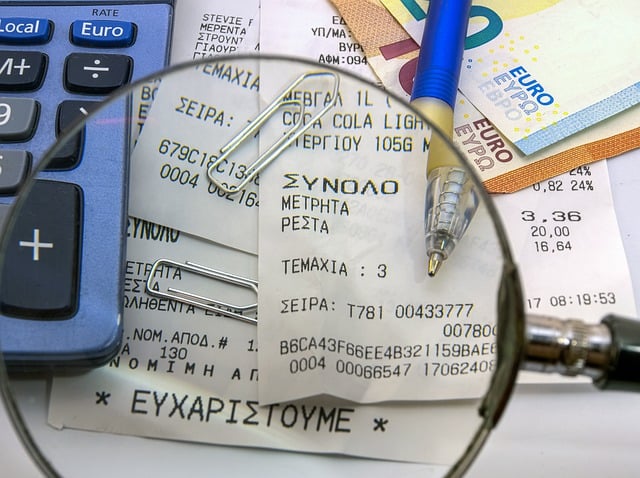This post may contain affiliate links, which means that we get commissions for purchases made through such links, at no additional cost to you. As an Amazon Associate we earn from qualifying purchases.
This article talks extensively about what receipt paper is made of. Many people who use thermal receipt papers often wonder about its composition. Our team has examined several brands of thermal receipt papers, and in this post, we will give you all the details about what they are made of.
What is receipt paper made of? Thermal paper rolls often called receipt papers, are made of a substrate layer which is plain paper, and layers of special coating. The printable surface of thermal receipt papers has a pre-coat layer and a thermal layer. Other than these, some thermal receipt papers have protective coatings on either surface of the paper. This means that thermal papers have a base paper layer coated with two to four chemical layers.
As you read on we will briefly explain each of the layers of receipt papers. We will also look more closely at the thermal layer and what it contains. Read on to find out more about the composition of receipt papers.

What Are The Layers of Thermal Receipt Papers?
The layers of thermal receipt papers are usually between three and five depending on the type. The three primary layers of a receipt paper are the substrate layer, the thermal layer, and the pre-coat layer that joins the thermal layer to the substrate layer. The substrate layer is made up of plain paper while the thermal layer contains the heat-sensitive ink pigments that create imprints on the paper. Aside from these three primary layers, some thermal receipt papers also have a top coat and reverse coat for additional protection.
Let’s take a closer look at each of these five layers:
Substrate Layer
The substrate layer is where the life of a receipt paper begins. This layer is made up of the paper material itself, which is often a product of wood pulp. It is the fundamental layer that carries all the other coatings of the receipt paper. The base sheet or substrate layer of receipt papers varies in density from one product to the other.
Pre-coat Layer
This layer, also called the “base coat”, functions like a primer that seals the substrate. It fills up every space between the surface fibers of the substrate paper and provides an even surface for the active thermal coating to stay on. This layer also absorbs activated dye pigments after printing, thus stabilizing the printed receipt.
What’s more, without this layer, the melted dye will stick to the printhead of your thermal printer and may damage it. But by absorbing the activated dye pigments, the pre-coat layer prevents this from happening.
Thermal Coat Layer
The thermal coat layer is also known as the “Active Coat” layer of the thermal paper. This layer is the one responsible for creating imprints on the thermal paper upon heat application. It contains colorless heat-sensitive dye pigments that change color as a response to heat application.
This layer contains two major substances – leuco dye crystals and color developers. These two substances are usually separated by a solid solvent. But some thermal papers hide the dye crystals in a microcapsule to prevent them from mixing with the color developer (usually BPA).
Upon the application of heat during printing, heat will either melt the solid solvent or burst the microcapsule, as the case may be. This allows the dye crystals to react with the color developer and create black or blue imprints on the receipt paper.
Top Coat Layer
This layer is made up of clear PVA. It seals the thermal coat layer and protects it from environmental elements. While this layer is optional, receipt papers that have it often last longer and can hold up to harsh elements, such as water and chemicals, and stressed environments better.
Reverse Coat Layer
The reverse coat is the optional layer of coating that some manufacturers apply to the back surface of their receipt paper. It adds more protection to the image printed on the receipt paper. Thermal labels with a synthetic base, such as polypropylene, have an anti-static reverse coat. The anti-static coat can draw or generate static and break down electronic components.
✅ Video – Thermal Paper – Chemistry in Everyday Life I
This video was created by the Hong Kong University of Science and Technology to explain the chemistry behind thermal paper receipts to their first-year chemistry students. The video shows and describes the different layers of thermal papers and explains how they interact to generate imprints.
What Are The Components of The Thermal Coat Layer?
The thermal coat layer of receipt papers consists of over ten chemical compounds that interact to produce imprints whenever the paper comes in contact with heat. These chemical compounds include dye pigments (leuco dyes), color developers (or organic matrix), and sensitizers. The dye pigments are initially colorless, but the heat makes them react with the organic matrix to produce color imprints during printing.
The thermal coat layer is the most important layer of coating on the thermal paper. Without this layer, the receipt paper will not be able to generate any imprints. Let’s take a closer look at the different components of this layer:
Leuco Dye
Leuco dye contains heat-sensitive colorless crystals that are finely ground into powdered form. . The crystals are often contained in several microcapsules. And during printing, the heat from the printheads of thermal printers melts the microcapsules anywhere it is applied. Wherever the microcapsules melt, the dye pigments will burst out and mix with the organic acids of the color developer to create imprints.
Color Developer
The color developer is usually made of organic acids. The most common developers used in receipt papers are BPA (Bisphenol-A) or BPS (Bisphenol-S). These two compounds have been proven to have toxic effects on humans and animals. As such, extended and consistent exposure to thermal papers may not be safe. In the next section, we will explain how to limit your exposure to these toxic chemicals.
Sensitizers
Another set of important compounds in the thermal coat layer of receipt papers are the sensitizers. These compounds determine the heat or temperature level that will activate the coating to form imprints. They also help the dye pigments to mix well with the developer.
What Are The Dangers of BPA and BPS In Receipt Papers?
Bisphenol-A and Bisphenol-S are known to be endocrine disruptors. This means that when they enter the body, they imitate certain hormones and cause unwanted hormonal reactions in the body. Some of the hormones that BPA and BPS often mimic include thyroid hormone and estrogen. This means that exposure to toxic levels of these compounds can disrupt metabolic and reproductive functions in the body. Some of the health problems that experts have linked to BPA and BPs include certain cancers (including breast and prostate cancer), obesity, metabolic syndrome, and diabetes.
Sadly, about 90% of receipt papers contain either BPA or BPS. This means it is highly unlikely for you to handle receipts and not come in contact with these toxic chemicals. However, experts have stated that the risk of toxic effects increases drastically for those who handle receipt papers regularly and for an extended time. As such, cashiers and others who work with receipt papers for several hours daily are more at risk than the ordinary customers, who may handle only a few receipts daily.
How Can You Reduce Exposure to Toxic BPA and BPS in Receipt Papers?
Here are a few tips to help minimize your exposure to the toxic compounds- BPA and BPS from receipt papers:
Seek Alternatives
As much as possible, you should refrain from accepting receipts. You can choose to receive an email receipt or a text message receipt instead. This option has become increasingly available in many businesses.
Mind Where You Touch
If you have no other choice than to accept a paper receipt, avoid touching the glossy front surface as much as you can. This surface has far more BPA or BPS than the non-glossy back surface.
Careful Handling and Storage
Handle receipt papers carefully and store them in envelopes or enclosed spaces. If you carry your receipt papers around with you and handle them carelessly, the toxic compounds will contaminate everything the receipt paper comes in contact with – your hands, wallet, pause, pocket, and even the money.
Wash Your Hands
Wash your hands quickly whenever you touch or handle a receipt. Make sure to scrub your hands well with warm water and soap. You should do this within four minutes of handling the receipt paper; else it’ll be too late already.
The use of hand sanitizers after handling thermal receipts is discouraged until after you have washed your hand. Alcohol from hand sanitizers will kill germs but it will not wash off toxic chemicals. Instead, it may react with the chemical and make it even more toxic. Using hand sanitizer before or after handling thermal receipts increases BPA or BPS absorption about 185 times more and drastically increases health risks, such as cancer, infertility, and heart disease, among others.
Use Latex Gloves
If you work as a cashier and frequent contact with receipt papers is inevitable for your job, put on latex gloves whenever you’re at work. This will prevent direct contact with the toxic chemicals in the thermal receipts.
✅ Video – BPA in Thermal Paper
This video explains the toxic effects of BPA in thermal receipt papers and a few things you can do to protect yourself from these toxic effects. The explanations are simple and straightforward. Do you know that certain people should never handle thermal paper receipts? You will find a list of these people in this video. Watch to learn more.
Related Questions
Are Paper Receipts Recyclable?
You should not recycle thermal receipt papers because they contain BPA (or sometimes BPS). These toxic chemicals cannot be removed during the process of recycling. As such, they would contaminate other paper materials during recycling. So rather than recycling, you should simply trash thermal receipt papers. That way, you will be able to isolate the toxic BPA from contaminating the environment.
The negative effects of trying to recycle thermal receipt paper are far-reaching. Products made from recycled paper often include facial tissue, shopping bags, and paper towels. If any of these items have either BPA or BPS, they would even bring the toxic chemicals closer to the body and thus increase health risks.
Is Receipt Paper Made From Trees?
The base layer of thermal receipt paper is made of the paper substrate, which is produced from the wood pulp of trees. So it is safe to say that receipt papers are made from trees. However, thermal receipt papers contain other layers aside from this base layer of paper substrates.
Do I Need To Shred Receipts?
You don’t have to shred receipts except they contain sensitive information. Such receipts that you should shred include receipts issued by credit card transactions. These receipts usually contain the last 4 digits of your credit card number, as well as your signature. Shredding these receipts before disposing of them will help keep your sensitive info secure.
You should shred such receipts and not burn or compost them. If you burn and compost a thermal receipt, it will release toxic BPA (or BPS in some cases) into the soil or atmosphere.
Conclusion
The composition of receipt papers includes regular paper and several chemical compounds. In this post, we have explained the different layers that make up the thermal receipt paper. We have also explained the composition of the thermal coated layer. This knowledge of the composition and chemistry of thermal papers should help you understand how they work, how to safely handle them, and how to safely dispose of them.
